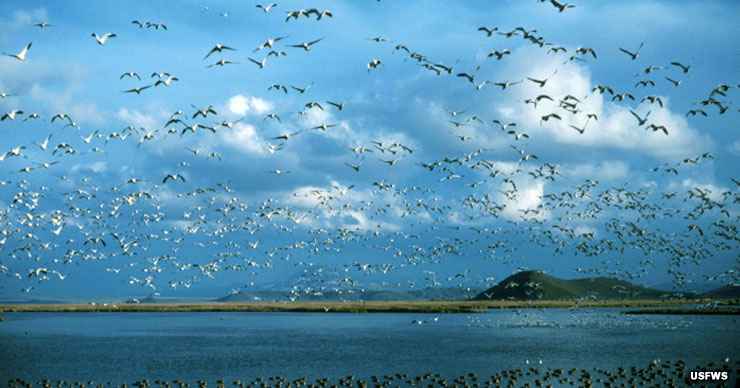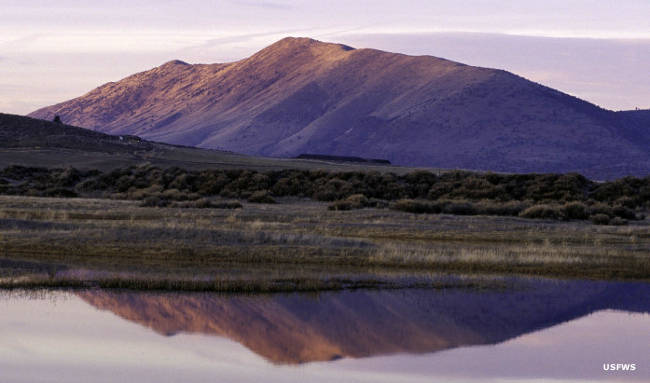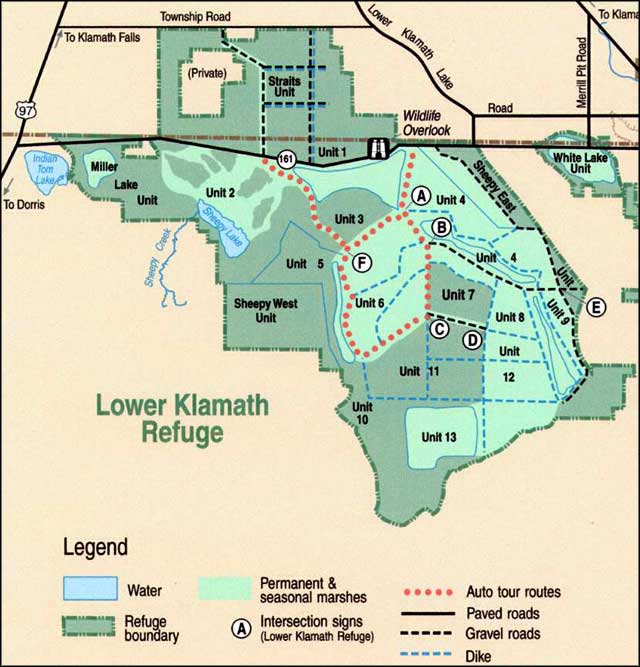Lower Klamath National Wildlife Refuge

Snow geese above Lower Klamath National Wildlife Refuge
In 1908, President Theodore Roosevelt established Lower Klamath National Wildlife Refuge as the first national waterfowl refuge in the United States. The 50,913-acre property straddles the border of California and Oregon (with 44,294.5 acres in California, 6,618.1 acres in Oregon). The property is a mix of open water, shallow freshwater marsh, cultivated croplands and grassy uplands.
Lower Klamath NWR is managed by US Fish & Wildlife Service personnel to provide excellent habitat for waterfowl during the spring and fall migrations. The Klamath Basin has lost more than 80% of its original wetlands in the last 150 years. That means the wildlife habitat in the area has been severely challenged, challenged to the point where it became necessary to take positive action to preserve habitats and local wildlife to maintain the natural biological diversity of the area. At the same time, Fish & Wildlife has to take into account maintaining a balance between wildlife and sustainable agriculture in the area. That includes maintaining natural populations of predators that keep the pest populations in check. To that end, the refuge operates an extensive wetland/cropland rotation scheme, fed by an extensive series of ditches, canals and water-flow control structures.
Among the birds that frequent the property you'll find golden and bald eagles, American white pelicans, white-faced ibis, Peregrine falcons, pintails, mallards, canvasbacks, gadwalls, black terns, tri-colored blackbirds, Western grebes, eared grebes, Canada geese, white-fronted geese, snow geese, Ross geese, coots, great egrets and others.
For human visitors, Lower Klamath NWR offers a well-marked, year-round ten-mile auto tour which gives excellent access to bird-watching opportunities. The refuge also has several photo blinds scattered around the property for use by photographers and the general viewing public.
The refuge center is open Monday through Friday, 8 am to 4:30 pm, and weekends 9 am to 4 pm, except Thanksgiving, Christmas and New Year's Days. The property is for day-use only, camping and campfires are not allowed.
To get there: from the south, get off Interstate 5 at Weed and follow Highway 97 northeast for 45 miles. At the Oregon border, turn east on Stateline Road (Highway 161) and go to Hill Road. Turn south on Hill Road and go about 4 miles to the refuge entrance. From the north: go 20 miles south of Klamath Falls on either Highway 97 or Highway 39. At the junction with Highway 161, go east to Hill Road from Highway 97 or west to Hill Road from Highway 39.
Lower Klamath National Wildlife Refuge is administered as part of the Klamath Basin National Wildlife Refuge Complex.

Sunrise at Lower Klamath National Wildlife Refuge

Upper photo courtesy of Tupper Ansel Blake, US Fish & Wildlife Service
Lower photo courtesy of John and Karen Hollingsworth, US Fish & Wildlife Service